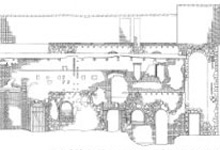Introduction The aim of this project is the reconstruction of the former Vorwerk (a secondary farm in manorial agriculture) in Bärwinkel (Neuhardenberg) and the development of the dairy building as a museum. The dairy was the first major project of Carl Friedrich Schinkel, and is today a listed building along with the entire ensemble of the farm.
As part of decentralised manorial farming of the reformed agriculture of late pre-industrial times, the site was constructed as an ornamented farm, according to plans attributable to the Gilly offices. The largely preserved site is significant beyond the region, indeed, its singularity gives it European rank. The dairy resembles an Early Christian basilica and served as lodging for administration, as a working dairy, and as a folly-like lodge for landowners (use as a freemasons lodge is hypothesized).
The shape of the farm rejects the then customary three- or four-sided farms erected around rectangular courtyards and is therefore unique. Similarly, the dairy itself was not constructed as a customary residential building.
Those familiar with the work of Schinkel determine the dairy in Bärwinkel to be the first romanesque building in continental Europe. The significance of the site as a part of the agrarian revolution therefore transcends various aspects of art and cultural history. Creator of this artfully designed ensemble was the most influential architect of the nineteenth century in the German states.
In 1990, the then ruinous remains of the dairy were measured (see fig 2), by 1995 the building was secured and temporarily reconstructed. Today many of these temporary measures have been replaced by more permanent reconstruction/restoration measures, permitting permanent access to the building.
In 2001-2002, the northern stable building (see figs. 11,12) was secured with the aid of a qualification scheme for young unemployed members of the community. The roof of the south wing was reconstructed etc. etc. Since the opening of the permanent exhibition Der Junge Schinkel 1800 – 1803 in June 2006, almost three thousand visitors have shown interest in the site.
The aims of the project:
a) the future museum will preserve the first major project of Carl Friedrich Schinkel, the nineteenth century’s most influential architect of the former German states.
b) he transformation that is to take place in the wake of the project will preserve and present the first Romanesque building in continental Europe, incidentally a unique example of an ornamented farm, thus presenting an ensemble of considerable significance to European cultural heritage.
c) the museum will exhibit hitherto marginalized early work of Carl Friedrich Schinkel more comprehensively than the current temporary exhibition Der junge Schinkel 1800-1803, as well as elaborating upon the agrarian revolution within and beyond the context of regional economic history.
d) reconstruction, restoration and modernisation of the dairy already showcase an innovative combination of monument preservation and sustainable technology, and will continue to become a notable example of the integration of sustainability with historical architecture.
e) the museum will promote cultural tourism (a significant sector of the European economy) in the region and provide incentive for further development.
From 2011 to 2013, fundamental steps toward the permanent recreation of the site as well as the construction of the museum in place of the temporary exhibition can be taken. Federal, state, and local authorities, the community, and many who are fascinated by the site welcome and support the project. Funds toward the restoration of the dairy as a ‘basilica’ have been secured, though considerable amounts are still necessary.
The Förderverein Bärwinkel e.V. kindly asks for your support.
Berlin, May 16th 2011
Frank Augustin, President
